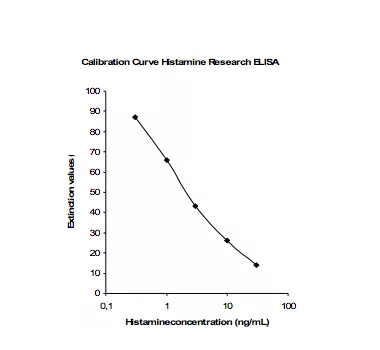Histamine ELISA kit
Ultra-Sensitive – Any sample
Ref: BA-E-5800R
 +
+Research Histamine ELISA
DatasheetProtocolMSDS
This research Histamine ELISA kit enables the ultra-sensitive measurement of histamine in any biological sample: tissue homogeneates, cell culture supernatants, body fluids, etc. With a minimal sample volume as low as 10µl, this histamine immunoassay allows longitudinal studies in mice and rat models.
| Sample type | 10µl |
| Samples/kit | 40 samples in duplicate |
| Sensitivity | 0.2ng/ml |
| Range | 0.5 – 50ng/ml |
| Assay time | Sample acylation (1h30) and ELISA overnight |
| Reactivity | Reacts with all species |
| Citations | Cited in 4 papers |
They published with this product see papers
Product overview
| Product name | Histamine ELISA kit – Any sample – Research |
| Description | Enzyme immunoassay (ELISA) for the quantitative determination of histamine levels in biological samples. Research use only |
| Format | 96-well plate |
| Samples | 10µl, any sample |
| Reactivity | Reacts with all species |
| Standard range | 0 / 0.5 – 50ng/ml |
| Sensitivity |
0.2 ng/ml |
| Specificity | No significant cross-reactivity was observed with Histamine analogs such as 3-Methyl-Histamine, Tyramine, L-Phenylalanine, L-Histidine, L-Tyrosine, Tryptamine, 5-Hydroxy-Indole-Acetic Acid, Serotonin |
| Assay time | 1h30 sample acetylation + ELISA overnight |
| Storage | Store at 2-8°C for up to 6 months |
| Datasheets | Instructions for use, Material safety datasheet |
| Sample preparation | Sample predilution and acylation (1h30) |
| ELISA | Histamine antiserum incubation (3H or overnight), revelation and read steps (1h30) |
| Detailed protocol | Download instructions for use |
Product citations
- Establishment and Characterization of Mild Atopic Dermatitis in the DNCB-Induced Mouse Model
Check the article
Authors : Riedl et al.
2023-08 - Ganglioside GM3 deficiency enhances mast cell sensitivity
Check the article
Authors : Komuro et al.
2023-04 - Streptococcal sagA activates a proinflammatory response in mast cells by a sublytic mechanism
Check the article
Authors : Von Beek et al., Cellular Microbiology
2019-07 - Decreased viability and proliferation of CHANG conjunctival epithelial cells after contact with ultraviolet light-irradiated pollen
Check the article
Authors : Heidinger et al., Cutaneous & Ocular Toxicology
2017-12






